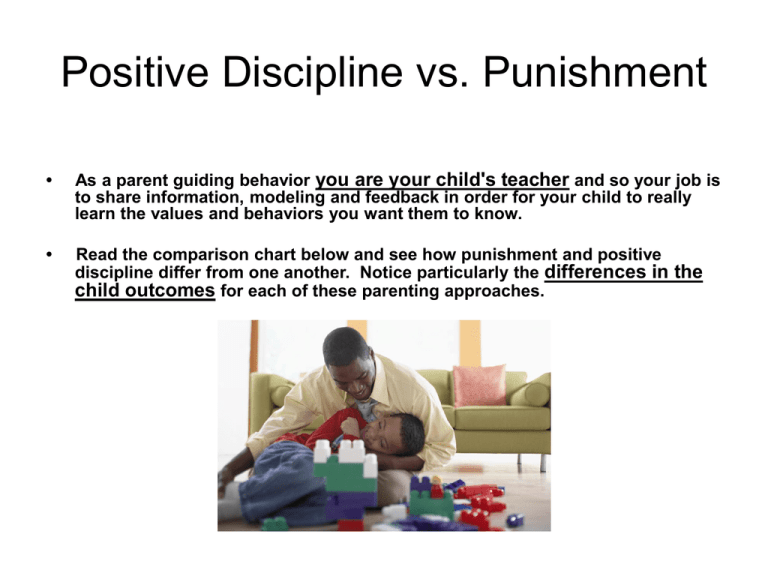Positive Discipline vs. Punishment
advertisement

Positive Discipline vs. Punishment • As a parent guiding behavior you are your child's teacher and so your job is to share information, modeling and feedback in order for your child to really learn the values and behaviors you want them to know. • Read the comparison chart below and see how punishment and positive discipline differ from one another. Notice particularly the differences in the child outcomes for each of these parenting approaches. Punishment vs. Positive Discipline Punishment Parent’s Goals: • • Stop behavior • • Obedience • • Peace and quiet • • Control • • “Knee jerk reaction” Typical Parenting Strategies: • • Coercion • • Time outs • • Threats • • Spanking • • Yelling Child’s Reaction/Learning: • • More defiance • • Might makes right • • Rigid boundaries • • Fear and distant relationship Child Outcomes: • • More dependent • • Revengeful or withdrawn • • Less skilled at solving problems Positive Discipline Parent’s Goals: • • Correcting behavior • • Cooperation • • Have the learning remembered • • Fostering self-discipline • • Thoughtful of long run Typical Parenting Strategies: • • Give reasons • • Modeling appropriate behavior • • Logical and natural consequences • • Problem-solving • • Teaching new behavior Child’s Reaction/Learning: • • More cooperative in long run • • Reasons for behavior • • Flexible boundaries • • Respectful, close relationship Child Outcomes: • • Independent • • Good team member • • Sees many solutions to problems • • Good decision maker Children’s Goals for Behavior • Children want to have contact, power, protection and independence....and all at the same time! Their behavior, good or bad, is motivated by one of these goals. If they can't get what they need in a positive way they will learn to get it in a negative way. • Below is a brief chart adapted from Active Parenting by Michael Popkin,Ph D that shows the goals children have and the positive and negative behavior they may show to reach the goal. Do you recognize any of these behaviors? Children’s Goals for Behavior Basic Goal of Child Contact Positive Negative Behavior Behavior Seeks Seeks undue recognition attention Power Shows Rebellion independence Protection Being assertive, Seeks revenge forgiving Independence Seeks Avoidance, centeredness gives up on their own Parenting Actions • By increasing positive behavior and decreasing negative behavior parents can help their children learn to behave in acceptable ways. There are many parenting strategies to increase behavior or decrease behavior that are included in a positive discipline approach. • Take a moment and think of one way you helped your child increase positive behavior today and one way you helped them decrease a negative behavior. How did you feel about using those strategies? • A challenge for parents is to stop using discipline strategies that you really don't like to use, strategies that you feel bad about after you have used them. Maybe it is yelling too much, physically grabbing or spanking, or calling your child names or putting them down when they misbehave. • Make a list of parenting strategies that you do not want to use. Post this list somewhere where you will see it daily and be committed to using other strategies for guiding your children each day. It takes practice to learn new parenting behavior and the first step is awareness of what you want to change. Now close this window to get back to the ECFE Positive Discipline homepage.











